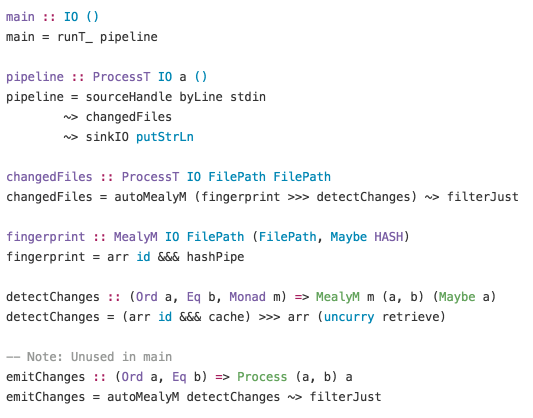Uniqhash Machines Implementation Using MealyM

I have a little program that I implement with various streaming frameworks in order to test out their capabilities with a range of orthogonal requirements. I call this program “Uniqhash”.
Ostensibly, the program takes in lines of filepaths on STDIN, and when it reads a new filepath, if the contents are different from the last time that it read the filepath, then it should output the filepath to STDOUT.
A use-case for this could be a Unix-pipeline composable piece of something like Guard. With the file-system event listener outputting filepaths, Uniqhash checking that the files have changed, and a STDIN responding script performing an action (such as “refresh-browser”). This isn’t purely hypothetical either. I use this workflow with the three pieces being “Commando”, “Uniqhash”, and “Conscript” regularly.
$ commando -j -p cat | grep --line-buffered -v git \
| uniqhash \
| tee /dev/stderr \
| conscript chromereload uniqhash_machines
The black-box requirements for Uniqhash are simple enough, but there are several other requirements that I have come up with that seem to stump whatever implementation I have attempted to design in the past:
- External Composability (Unix Pipelines)
- Internal Interface Composability (Ideally Categorical)
- Internal Sub-Component Composability (Requiring Least Possible Context)
- Safety (Resource Safety)
- Safety (Exception Handling)
- Idiomatic use of Components
- Computational Lattice Construction (Constructed as a Computation Graph)
- Effect Interleaving Capability Where Required
- Lock-Step Evaluation of Divergent Paths in Computation Graph
- Execution Speed
If these requirements are met then they facilitate testing, sub-component reuse, expressiveness of implementation, etc. Unfortunately it has been easy to satisfy many, but not all of these with any particular single attack… Until now!
- Lazy-IO
met all requirements except for Safety and Idiomaticity, with
exceptions triggering problems in unexpected locations, resource usage
being tricky to get right, and several calls to
unsafeInterleaveIOscattered throughout the implementation. - Conduit
and
Pipes
both provide fantastic facilities for streaming, but they
fall down when composing together components in a graph - requiring
either large blocks of low-level plumbing code without much
component reuse, or losing the Lock-Step Evaluation capability
and requiring regaining divergent association through the use
of
Eithers(and possibly tracking IDs to boot). - Machines
seemed very promising, fulfilling all needs, except for not quite
being able to express graphs. It could express tributary trees
of effectful computation using
WyeandTee, but causing a source to diverge, then rejoin in lockstep with effects was not possible with the built in components. The Mealy-Machine seemed promising, and could solve the problem in a pure context, but then general effects were unable to be executed as the pipeline processed data… Still, it was so close that I decided to try creating an upgraded Mealy-Machine - the MealyM.
newtype MealyM m a b = MealyM { runMealyM :: a -> m (b, MealyM m a b) }
This has finally solved every one of the requirements that I’ve come up with to-date.
- The top-level program can be constructed
- The program can be exposed at the library level as a
ProcessMachine - This can be composed categorically with other libraries
- The sub-graphs of the implementation can also be reused
- The sub-graphs only demand as powerful a context as is required.
hashPiperequires IO, butcacheis pure…- Resources are handled safely
- Execution of the graph occurs in lock-step, requiring no special code to converge previously diverged paths
MealyMis idiomatic, fitting into the existingMachinesecosystem- Everything runs acceptably quickly

There are many nice properties of MealyM. One of my favorite is that
it has an Arrow instance. This allows for totally idiomatic construction
of computational-graphs. You should even be able to go about this
construction
with the hilariously fantastic Needle.
-- Like Magic:
-- *Needle> embedMealyM n (words "a b c a a a")
-- [Just "a",Just "b",Just "c",Nothing,Nothing,Nothing]
n :: MealyM IO FilePath (Maybe FilePath)
n = [nd|
}===\================\
\ { tuple }==\=============\
\=={ hashPipe }==/ \ { get }==>
\=={ cache }==/
|]
… Although I’ve had some trouble with Needle’s dependencies as it looks like it hasn’t been updated in some time… It’s glorious enough that I might just attempt to bring Needle up to date :D
I’ve had some discussions on both the machines and concurrent-machines repositories about what I’ve been trying to achieve and will hopefully have a pull request into both of these projects soon to share what I’ve made.
As it turns out MealyM is MStreamF
from dunai, which has a paper
about it.
Edit - Mon, 7th November
Some other packages brought to my attention after posting this to Reddit:
Whaddaya know!